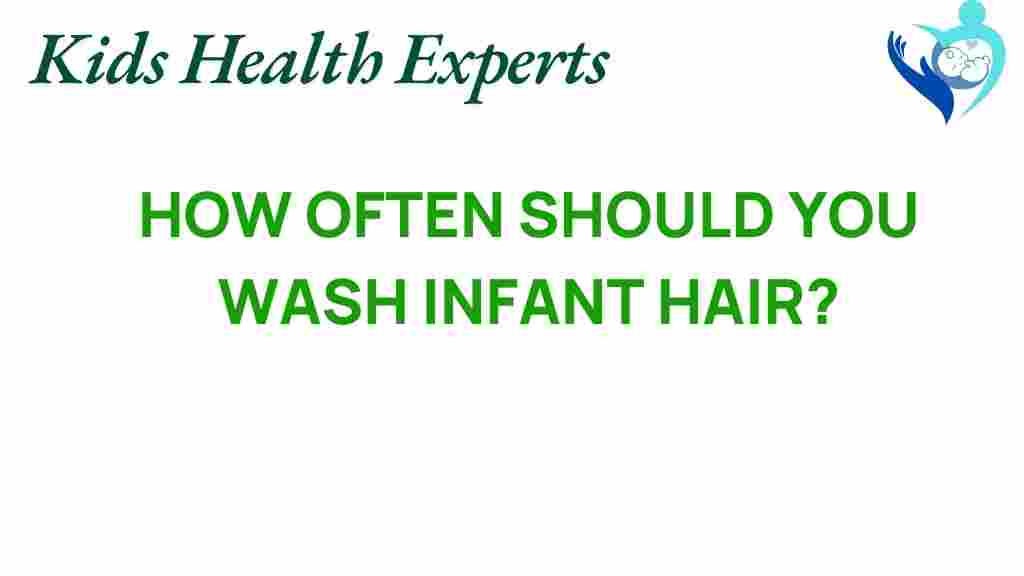The Surprising Truth About Washing Infant Hair: How Often is Too Often?
When it comes to infant hair care, many new parents are often unsure about the best practices to ensure their baby’s scalp remains healthy and clean. The frequency of washing an infant’s hair can vary widely, leading to confusion and concerns among caregivers. In this article, we will explore the best practices for washing an infant’s hair, discuss the importance of baby hygiene, and provide parenting tips to help you navigate this essential aspect of early childhood care.
Understanding Infant Hair and Scalp Health
Before diving into washing frequency, it’s essential to understand that an infant’s hair and scalp are quite different from those of older children and adults. Here are some key points to consider:
- Delicate Skin: An infant’s scalp is sensitive and can easily become irritated if subjected to harsh treatments.
- Natural Oils: Babies produce natural oils that help keep their hair and scalp moisturized, which is crucial for their overall scalp health.
- Cradle Cap: This common condition can occur in infants, leading to flaky or scaly patches on the scalp, which may require different care.
How Often Should You Wash Infant Hair?
The question of how often to wash an infant’s hair is often met with varying opinions. Here are some guidelines to help you determine the right frequency:
- Newborns: For the first few weeks, washing your newborn’s hair once a week is usually sufficient. Their hair is often fine and sparse, and the scalp does not collect much dirt.
- Older Infants: As your baby grows and begins to explore, you may want to wash their hair more frequently, about 1-2 times per week.
- Active Babies: If your baby is particularly active or prone to sweating, you may wash their hair more often, but ensure you use a gentle baby shampoo.
It’s important to find a balance that maintains cleanliness without stripping away the natural oils in the hair. Overwashing can lead to dryness and irritation, so be mindful of your baby’s unique needs.
Choosing the Right Products for Infant Hair Care
When it comes to infant grooming, selecting the right products is crucial. Here are some tips for choosing the best baby shampoo:
- Look for Gentle Formulas: Opt for shampoos that are free from harsh chemicals, fragrances, and sulfates.
- pH-Balanced: Choose products that are pH-balanced to support the delicate nature of your baby’s scalp.
- Hypoallergenic Options: If your baby has sensitive skin, consider hypoallergenic shampoos to minimize the risk of irritation.
Step-by-Step Guide to Washing Infant Hair
Here’s a simple step-by-step guide to washing your infant’s hair safely:
- Gather Supplies: Collect everything you need, including a soft washcloth, a gentle baby shampoo, a cup for rinsing, and a towel.
- Prepare the Bath: Fill the baby tub or sink with a few inches of warm water. Ensure the temperature is comfortable (about 37°C or 98.6°F).
- Wet the Hair: Use a cup to gently pour water over your baby’s head, making sure to avoid getting water in their eyes.
- Apply Shampoo: Take a small amount of baby shampoo and gently massage it into the scalp with your fingertips.
- Rinse Thoroughly: Use the cup to rinse the shampoo from your baby’s hair, ensuring all product is removed.
- Dry the Hair: Carefully towel dry your baby’s hair and scalp. Avoid vigorous rubbing to prevent irritation.
Troubleshooting Tips for Common Issues
While washing your infant’s hair, you may encounter some common issues. Here are tips to address them:
- Cradle Cap: If your baby has cradle cap, consider using a gentle brush to loosen the flakes during bath time. You may also apply a small amount of oil before washing to help lift the scales.
- Irritated Scalp: If your baby’s scalp appears red or irritated, try reducing the frequency of washes and ensure you are using a gentle shampoo.
- Hair Shedding: It’s normal for infants to lose some hair, especially in the first few months. If you notice excessive shedding, consult your pediatrician.
When to Consult a Pediatrician
While most issues can be managed at home, there are certain situations where you should seek professional advice:
- If your baby has persistent cradle cap that does not improve with regular washing.
- If you notice signs of infection, such as redness, swelling, or discharge from the scalp.
- If your baby’s hair is falling out in patches or if you have concerns about their overall hair growth.
Additional Parenting Tips for Infant Hair Care
To further enhance your infant’s hair care routine, consider these additional tips:
- Be Gentle: Always handle your baby’s hair and scalp with care to avoid causing discomfort.
- Create a Routine: Establish a regular bath time routine that includes hair washing, making it a familiar and enjoyable experience for your baby.
- Monitor Changes: Keep an eye on any changes in your baby’s scalp or hair condition and adjust your care routine accordingly.
Conclusion
Understanding the nuances of infant hair care is crucial for maintaining your baby’s scalp health and overall hygiene. By following the guidelines outlined above, you can find the right washing frequency that suits your baby’s needs, ensuring that their hair and scalp remain nourished and healthy.
Remember, every baby is different, and it’s essential to listen to your child’s cues and adjust your routine accordingly. With patience and care, you can navigate the world of baby hygiene and provide the best possible care for your little one.
For more tips on early childhood care, you can visit this helpful resource. If you’re looking for more information on general parenting practices, check out this informative guide.
This article is in the category Care and created by KidsHealthExperts Team
